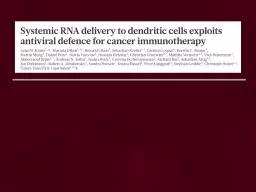

Proposed an efficient exosomebased tumor antigensadjuvant codelivery system Genetically engineered tumor cellderived exosomes Endogenous tumor antigens Immunostimulatory CpG DNA Source cells for exosome murine melanoma B16BL6 ID: 909932
Download Presentation The PPT/PDF document "Design principles and objectives:" is the property of its rightful owner. Permission is granted to download and print the materials on this web site for personal, non-commercial use only, and to display it on your personal computer provided you do not modify the materials and that you retain all copyright notices contained in the materials. By downloading content from our website, you accept the terms of this agreement.
Slide1
Design principles and objectives:
Proposed an efficient exosome-based tumor antigens-adjuvant co-delivery system:
Genetically engineered tumor cell-derived exosomes: Endogenous tumor antigensImmunostimulatory CpG DNASource cells (for exosome): murine melanoma B16BL6Target cells (for immune-activation): Dendritic cells DC 2.4
Slide2Cancer immunotherapy
Tumor antigen-based cancer immunotherapyInduce tumor antigen-specific cytotoxic T lymphocytes (CTLs)
C.G. Drake, E.J. Lipson, J.R. Brahmer, Breathing new life into immunotherapy: review of melanoma, lung and kidney cancer, Nature reviews Clinical oncology 11(1) (2014) 24-37.
Slide3Major challenges for tumor antigen-based cancer immunotherapyIdentification and purification of particular tumor antigens
Efficient delivery of tumor antigens to antigen-presenting cells (APCs)APC activation via adjuvants
Slide4Design exosome as carrier for cancer immunotherapy
Utilization of novel materials that can be used asAn endogenous tumor antigensA delivery carrier for adjuvantExosomes:
Serve as endogenous delivery carriers for proteins and nucleic acidsTumor cell-derived exosome:Contain endogenous tumor antigenCan transfer tumor antigen to APCsCan load small interfering RNAs or anti-inflammatory agentsRecent clinical application (colorectal cancer (CRC) (phase I trial)): ascites-derived exosomes (Aex) in combination with the granulocyte–macrophage colony-stimulating factor (GM-CSF)Hypothesized that adjuvant-modified tumor cell derived exosomes can simultaneous delivery of tumor antigens with adjuvant to the same APC
Slide5Experiment design
Exosome-based tumor antigens-adjuvant co-delivery system:Genetically engineered murine melanoma B16BL6 tumor cells: generate exosomes that
express SAV-LASAV-LA: a fusion protein of streptavidin (SAV) and lactadherin(LA)Subsequently modified these exosomes with biotinylated immunostimulatory CpG DNA (CpG-SAV-exo)
Slide6Preparation of CpG DNA-modified exosomes
Collection of SAV-exo from B16BL6 cellspDNA:
pCMV-SAV-LA and pCMV-Gaussia luciferase(gLuc)-LApDNA was mixed with PEI”Max” and the complex was added to B16BL6 for 1 hr.Subsequently, the remaining complex was removed and cells were cultured with exosome depleted medium for 24hrExosomes were collected from the culture supernatant.Preparation of CpG-SAV-exoSAV-exo was incubated with (fluorescein labeled) biotinylated CpG DNA for 10 minExosome membranes were stained with PKH26 or PKH67 dye
Slide7Characterization of CpG DNA modified exosomes
1pmol of
CpG DNA was combined with 1ug of exosome287 CpG DNA molecules per exosome
Slide8Cellular uptake of CpG-SAV-exo by DC2.4 cells
DC 2.4 cells were pre-seeded to 96 well at 5x104
cells/wellFluorescein-labeled/PKH67-labeled CpG-SAV-exo was added and incubated for 8hrMeasured by flow cytometry
Slide9Cellular uptake of CpG-SAV-exo by DC2.4 cells
DC 2.4 cells were pre-seed to 96 well at 5x104
cells/wellFluorescein-labeled/PKH67-labeled CpG-SAV-exo was added and incubated for 8hrMeasured by flow cytometry
Slide10Cytokine release by DC2.4 cells
DC 2.4 cells were pre-seed to 96 well at 5x10
4 cells/well for 24hr before treatmentExosome samples were added and incubated for 8 or 24hrThe culture supernatant were collected and TNF-α, IL-6, IL-12p40 were quantified by ELISA
Slide11Tumor antigen presentation by DC2.4 cells
DC 2.4 cells were pre-seeded to 96 well at 5x10
4 cells/well for 4hr before treatmentExosome samples were added to each well.BUSA14 cells (mouse T cell hybridoma cells –melanoma antigen gp100) were co-cultured with DC2.4 cells.After 24hr incubation, the culture supernatant were collected and IL-2 released from BUSA16 cells were quantified by ELISA
Slide12Tumor cells
T-cell lymphoma
Induction of B16BL6-specific immune response by CpG-SAV-exoExosome samples were intradermally injected into the left flank of C57BL/6 mouse.Mice were immunized three times at 3 day intervals.Seven days after the last immunization, 5x105 splenocytes collected from mice were incubated with mitomycin C treated B16BL6 cells or EG7 cells for 3 daysIFN-ϒ, IL-4, IL-10 and TGF-β1 were quantified by ELISA
Slide13Induction of B16BL6- humoral immune response by CpG-SAV-exo
Slide14Induction of B16BL6- Cytotoxic T-lymphocyte assay
Effector cells:Splenocytes
collected from immunized mice were restimulated with mitomycin C-treated B16BL6 cells for 4 daysTarget cells: B16BL6 cells and EG7 cells were separately labeled with 51Cr. Effector cells and target cells were co-incubated for 4hr.Measure radioactivity (51Cr)Spontaneous release of 51Cr:--in the absence of effector cellsMaximal release of 51Cr:--in the presence of 1% TritonX-100
Slide15Protective antitumor immunity induced by CpG-SAV-exo
Preventive model:Mice were intradermally
immunized for 7 days.After the last immunization, mice were subcutaneously inoculated with 5x105 B16BL6 cellsWhen the tumor exceeded 100mm3, exosome samples were injected again.Dose: 1μg exosomePreceding studies: 10-200 μg /dose
Slide16Therapeutic antitumor immunity induced by CpG-SAV-
exoPre-established tumor model
Intratumoral administration
Intradermal
administration
Slide17Therapeutic antitumor immunity induced by CpG-SAV-
exoAthymic BALB/c nu/nu mice: inoculated with B16BL6 cells
Investigate the imvolvement of T cells in antitumor immunity induced by CpG-SAV-exoResult: immunization with CpG-SAV-exo hardly inhibited the tumor growth in
athymic mice.
Slide18Influence of CpG-SAV-exo on the tumor
microenvironmentEvaluate the mRNA expression: VEGF, TGF-
β1The expressions were hardly changed by any treatments.
Slide19Influence of CpG-SAV-exo on the tumor
microenvironment
Evaluate the angiogenesis: hardly induced angiogenesis at tumor tissue by any treatments.
Slide20Influence of CpG-SAV-exo on the tumor
metastasisCollected the lung from tumor-bearing mice treated with
CpG-SAV-exo and counted the number of tumor nodules
Slide21Conclusions
CpG-SAV-exo antigen-adjuvant co delivery systemReduction in the required dose of exosomes via adjuvant modificationEfficient and simultaneous delivery